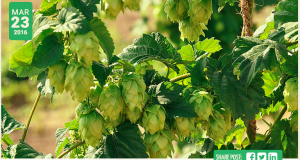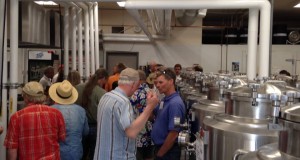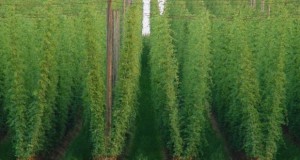A simple equation for calculating alpha and beta acid levels at 10 percent moisture.
By: Diane Brown | Michigan State University Extension | Sept. 5, 2013
You’ve spent an entire season nurturing and tending your hops, eagerly waiting for harvest. How can you determine whether or not your hops are ready to harvest? Before breweries will buy your hops, among other things, they will want to know what the alpha acid levels are.
A sample of cones can be sent to a lab for analysis to determine alpha and beta acids. Fresh hops are typically dried down to 8 to 10 percent moisture to prevent spoilage. Here is a formula to convert alpha acid and beta acid concentrations derived from analysis of wet hops to estimated dry hop concentrations at 10 percent moisture. Actual dry hop values may be different and will need to be tested to ensure accuracy, but the estimated values will help to determine whether or not the hops are ready to harvest. To use this formula, you will need the tested values for alpha acids, beta acids and the percent moisture in the test sample. Thanks to KAR Laboratories, Inc. for providing the formula below.
Tested acid value x (90/100-(percent moisture))
Here is an example using ‘Cascade.’ The normal range for alpha acids in Cascade is 4.5-7.0; the normal range for beta acids is 4.5-7.0. The values received from testing the wet hops in in our example were alpha acids = 3.38 beta acids = 5.23 and moisture: 34.38 percent.
Alpha acids = 3.38 x (90/(100-34.38)) = 3.38 x1.372 = 4.64
Beta acids = 5.23 x (90/(100-34.38))= 5.23 x 1.372 = 7.17
Based on this information, the ‘Cascade’ hops should be ready to harvest.
Here is an example using ‘Chinook.’ The normal range of values for Chinook = 12-14 percent alpha acid, 3-4 percent beta acid. The values received from testing the wet hops in in our example were alpha acids = 6.21 beta acids = 1.68 and moisture: 31.15 percent.
Alpha acids = 6.21 x (90/(100-31.15))= 6.21 x (90/68.85) = 6.21 x 1.307 = 8.1
Beta acids = 1.68 x (90/100-31.15))= 1.68 x 1.307 = 2.2
Based on these calculations, the ‘Chinook’ hops are not ready to harvest yet.
Determining whether the hops are ready to harvest comes with experience. In addition to testing, Michigan State University Extension recommends smelling the hops, checking the lupulin to see if it is bright yellow and perhaps brewing a cup of hop tea to taste the flavor of the hops and their bitterness.
Labs offering testing for quality analysis of hops
Contact individual labs for services offered, quantities of hops needed for testing and prices.
- Alpha Analytics, 203 Division St. Yakima, WA 98902; contact 877-875-6642 or info@alphaanalytics.com
- KAR Laboratories Inc., 4425 Manchester Rd., Kalamazoo, MI 49001; contact 269 381-9666
- Andre Venter, Western Michigan University Department of Chemistry, contact andre.venter@wmich.edu or 269-387-2420
To see the original article, click here.
 Ontario Hop Growers' Association The OHGA is a not-for-profit association of hop growers, families and enthusiasts who are interested in supporting the growth of the hop industry in Ontario.
Ontario Hop Growers' Association The OHGA is a not-for-profit association of hop growers, families and enthusiasts who are interested in supporting the growth of the hop industry in Ontario.



